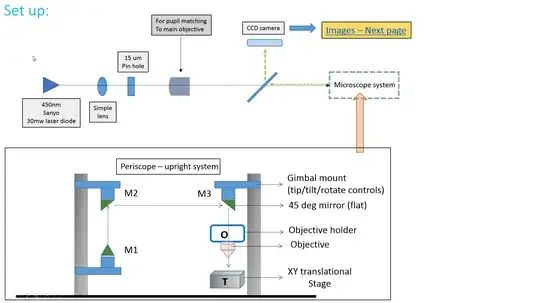The basic concept of optical alignment is to perfectly align the beam step-by-step on all optical elements. Enshure your beam has the right height and angle before alignment. Your aim to align the beam on microscope optical axis. Using point sources like (e.g. Flourescent beads, microspheres, Quantum dots, quantum wells, NV centers in diamond) allows an easy alignment to a point spread function on your CCD sensor.
On-axis with an iris aperture
A quick method uses an iris aperture to make a parallel beam to the optical axis. Insert Iris $A$ between M3 and M2. The open iris aperture should allow the beam to transmit in center. Place a mirror perpendicular to opical axis at the translation stage with remove microscope objective and ocular. The beam is reflected on the plane mirror and possibly hits the back side of iris aperture.
Iterate angle and position alignment
Using M3 to center the beam on back of iris apeture, while oving aperture up and down. Possible position errors shoule be aligned with mirror M1 an M2. These have the largest impact on position. Start iterating with angle alignment. This coarse alignment should allow to insert microscope elements and fine align the beam to microscope objective.
